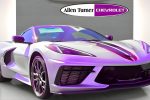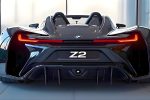The 1971 Plymouth Cuda Convertible stands as one of the most iconic and desirable Mopar machines ever created. With its aggressive styling, rumbling V8 engines, and extremely limited production numbers, this car has become a timeless symbol of American muscle. Even decades after its debut, the ’71 Cuda Convertible continues to capture the imagination of car collectors, enthusiasts, and anyone with an appreciation for classic design and raw mechanical power. Its presence on the road feels like a time capsule from an era when muscle cars defined freedom, individuality, and the thrill of pure performance.
A Brief Look at the Cuda Legacy
Before exploring the details of the 1971 model, it’s important to understand the legacy that the Cuda name carries. Plymouth introduced the Barracuda in the mid-1960s, but it wasn’t until the 1970 and 1971 models that the Cuda truly became a muscular icon. The brand embraced a more aggressive design, powerful engine options, and a bold personality that separated it from other muscle cars of the time. By 1971, the Cuda had already established itself as a serious contender among classics like the Chevrolet Camaro and Ford Mustang. What made the 1971 Cuda Convertible so special was its scarcity combined with its performance potential. It wasn’t just a muscle car. It was a statement.
The Distinctive Exterior Design
The 1971 Plymouth Cuda Convertible’s exterior design remains one of its most admired qualities. It was bold, muscular, and unmistakable even from a distance. The front end was characterized by the famous quad headlight setup and a more aggressive grille compared to the previous year. The fender gills, a unique styling element introduced in 1971, added personality and flair to the body. The flowing lines, sculpted hood, and low stance gave the car its commanding presence. The convertible roof added elegance, making it equally appealing for cruising or showcasing at classic car meets. The shaker hood, optional on the high-performance models, became one of the most recognized symbols of Mopar power. Its ability to shake with the engine’s rhythm brought the car to life even before hitting the road.
Convertible Appeal and Open-Air Driving
Driving the 1971 Cuda Convertible offers an entirely different experience. While the coupe version is aggressive and performance-oriented, the convertible adds a layer of sophistication and enjoyment. With the top down, the driver feels more connected to the engine’s roar, the wind, and the road ahead. In an era when convertibles were already popular, the Cuda stood out not only because of its styling but also because of its power delivery. The lightweight structure paired with powerful engines made top-down driving exhilarating. Today, the convertible models are cherished for their rarity. Only a small number were produced in 1971, making them incredibly valuable.
Engine Choices That Defined an Era
One of the strongest reasons behind the Cuda’s legend was its engine lineup. Plymouth offered a variety of powerful options that suited different types of drivers. The standard V8 engines provided impressive performance, but the real excitement came from the higher-end powerplants. The 340 and 383 engines delivered strong responsiveness, while the legendary 440 and Hemi engines turned the Cuda into a full-blown muscle monster. The 426 Hemi, in particular, elevated the Cuda into a category of its own. Known for its brute power and racing heritage, the Hemi engine made the Cuda a dream machine for performance enthusiasts. Even today, Hemi-equipped convertibles are considered some of the rarest and most valuable Mopars ever built.
Performance on the Road
The driving experience of the 1971 Plymouth Cuda Convertible blends raw muscle with surprising comfort. The suspension setup, while firm, offered good stability for a car of its time. The steering delivered a direct connection to the road, giving drivers confidence during spirited drives. Cars with performance packages, such as the Hemi or 440, provided aggressive acceleration and exhilarating soundtracks. Although modern performance cars outperform these classics in raw numbers, few vehicles match the emotional thrill of driving a Cuda. The convertible model enhances this feeling even more, allowing the driver to fully experience the roar of the engine and the breeze of the open road.
Interior Design and Comfort
The interior of the 1971 Cuda Convertible reflects the design approach of the early 70s. While simple compared to modern standards, it had all the essentials. The driver-focused dashboard, the pistol-grip shifter, and the bucket seats created a sporty atmosphere. The materials used were durable yet stylish, and the layout ensured easy access to controls. The convertible cabin offered a sense of freedom not found in closed-body cars. Even though the interior design was not overly luxurious, it delivered the right mix of practicality and charm. The bright interior color options added vibrancy to the overall experience, reflecting the bold design language of the era.
Rarity and Collector Appeal
The 1971 Plymouth Cuda Convertible is one of the rarest muscle cars ever produced. Plymouth manufactured only a few dozen units, and only a handful survived in original condition. The limited numbers combined with high demand have made this car one of the most expensive and sought-after Mopars in history. Collectors around the world view it as a prized possession. Auction prices for original or well-restored models often reach astonishing numbers. Hemi-equipped convertibles are considered holy grail cars among American muscle enthusiasts. Its rarity is one of the primary factors behind its rising market value, but it’s more than that. It’s the car’s iconic status, timeless design, and unmatched personality that make it a legend.
Timeless Design and Cultural Impact
The 1971 Cuda has become a cultural symbol that transcends generations. Its appearance in movies, car shows, and collectible art reinforces its place in automotive history. The sculpted body lines and aggressive features represent the peak of American muscle car styling. While modern vehicles focus on refinement and efficiency, the 1971 Cuda continues to embody the raw spirit of freedom and power. The convertible variant adds a layer of elegance, proving that a muscle car can be both fierce and stylish. Even people who are not familiar with Mopar history can instantly recognize the Cuda, making it one of the most influential designs of its time.
Why This Car Remains Iconic Today
There are several reasons why the 1971 Plymouth Cuda Convertible remains iconic. Its extremely limited production makes it a rare treasure. Its powerful engine options place it among the strongest muscle cars ever built. Its bold design continues to influence modern interpretations of retro muscle. Most importantly, the Cuda represents an era of pure automotive passion. It symbolizes the time when cars were built with emotion, character, and mechanical soul. Even today, owning or driving a Cuda is a dream for many enthusiasts worldwide. Its legacy is preserved not only by its rarity but also by the community of car lovers who admire and restore these machines.
Final Verdict
The 1971 Plymouth Cuda Convertible is more than just a classic muscle car. It is a masterpiece that blends performance, design, and emotional appeal in a way few vehicles ever have. Its limited numbers make it a rare jewel, while its performance and styling continue to inspire admiration. Whether seen in a museum, at a car show, or cruising on an open highway, the Cuda Convertible commands respect. Its timeless design, powerful engine lineup, and cultural significance ensure that its legacy will live on for generations. Among the icons of American muscle, the 1971 Cuda Convertible holds a special place that no other car can replicate.
Disclaimer
This article is based on historical information, enthusiast accounts, and general automotive knowledge. Specifications and descriptions may vary depending on individual vehicles, restorations, and modifications.


